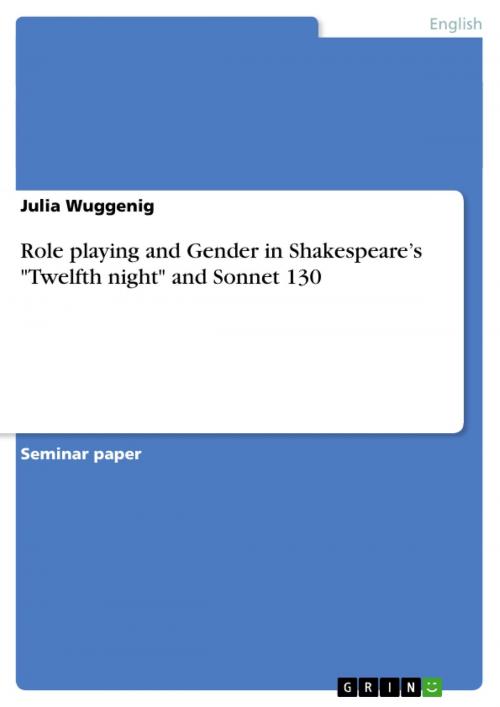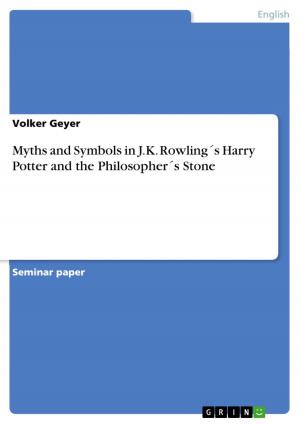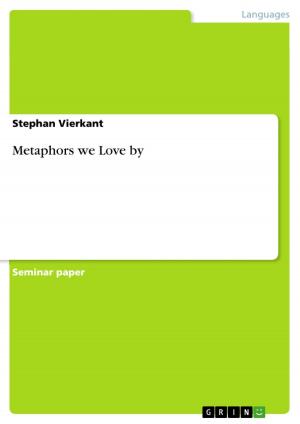Role playing and Gender in Shakespeare's 'Twelfth night' and Sonnet 130
Fiction & Literature, Literary Theory & Criticism, British| Author: | Julia Wuggenig | ISBN: | 9783656723479 |
| Publisher: | GRIN Publishing | Publication: | August 20, 2014 |
| Imprint: | GRIN Publishing | Language: | English |
| Author: | Julia Wuggenig |
| ISBN: | 9783656723479 |
| Publisher: | GRIN Publishing |
| Publication: | August 20, 2014 |
| Imprint: | GRIN Publishing |
| Language: | English |
Seminar paper from the year 2013 in the subject English Language and Literature Studies - Literature, grade: 2,3, University of Stuttgart (Institut für Literaturwissenschaft), course: Einführung in die Literaturwissenschaft, language: English, abstract: I Introduction This term paper examines the question in what way Shakespeare's sonnett Nr. 130 represents a woman, how the woman is represented in his 12th Night and how these representations correspond or disagree with the conception of a woman at Shakespeare's time under the reign of Queen Elizabeth I. This issues shall be considered under the New Historicist Approach. New Historicism is a literary theory which takes a closer look at cultural concepts and values at a given time and 'the relationship between individual subjects and discourses'. (Meyer 189) This means for the examination of Shakespeare's Sonnett and 12th night: how is a woman represented in the poem? How is a woman represented in the comedy and what does it mean that a woman performs the role of a man? To what kind of woman in Shakespeare's time under the reign of Elizabeth I could both pieces of literature refer to? Both the Sonnet and the comedy carry traces of the Petrarcan tradition of poetry. Whereas the Sonnett parodies this traditionnal language of love using the original form altered by 'Sir Thomas Wyatt (1503-1542), Henry Howard and Early of Surrey (1517-1547)' (Meyer 53) into the English Sonnet, the comedy parodies the language of the Petrarcan lover by making a woman use this sophisticated language, disguised as a man. The subversive quality of that fact is obvious: a woman impersonating a man on stage could be seen as a parallel to a woman representing a man in English society. But it also points to the real situation of Elizabeth I on the English throne, enacting the duties which were the ones of a King before. This ambigious situation we will examine under the point of view of role game play. If we go back to the Sonnet, we could think about if this Sonnet doesn't attribute a man's qualities to a woman as well, as we shall see later.
Ausbildung 2012-2017Doktorarbeit. Universität Stuttgart. Titel: 'Intermedialität am Beispiel von Lech Majewskis The Mill and the Cross, Gustav Deutschs Shirley - Visions of Reality und Jean-Luc Godards Passion (bewertet mit 'Cum Laude') 2013-jetztZusätzliches Lehramtsstudium an der Universität Stuttgart in den Fächern Englisch und Französisch 2004-2011Magistra Artium in Kunstgeschichte und Französisch an der Universität Stuttgart 2004Abitur in den Fächern Musik und Französisch. Stromberg Gymnasium, Vaihingen an der Enz 2000Viermonatiger Auslandsaufenthalt in Frankreich. Lycée Climatique, Argèles-Gazost Arbeitserfahrung 2015-2017Freier Mitarbeiter der Firma Happy Media UG. Einsatzbereiche: Onlineredaktion 2014-2016Nebenjob auf 450 Euro Basis an der Städtischen Galerie Bietigheim-Bissingen 2015Kurzpraktikum in der Galerie Merkle, Stuttgart. Einsatzbereiche: Ausstellungsorganisation, Pressearbeit 2014Einmonatiges Praktikum an der Städtischen Galerie in Bietigheim-Bissingen. Einsatzbereiche: Ausstellungsorganisation, Ausstellungsumbau, Textarbeit, Bildbearbeitung 2008Dreimonatiges Praktikum, Musée du Louvre, Département des Arts Graphiques, Paris. Einsatzbereiche: Dokumentation der Kunstwerke in den Sprachen italienisch, französisch, deutsch; Ausstellungsorganisation, Arbeit mit Originalen 2008Dreimonatiges Praktikum. Editions Artfise, Paris. Einsatzbereiche: Lektorat von Bildunterschriften und Texten, Auswahl der Bilder für Kunstbücher 2007Im Auftrag der Staatsgalerie Stuttgart. Mitarbeit bei einer Umfrage bei den Besuchern mit dem Ziel die Besucherzahl der Staatsgalerie insgesamt zu erhöhen SprachenDeutsch: Muttersprache, Englisch: verhandlungssicher, Französisch: verhandlungssicher, Spanisch: gut, Italienisch: gut, Ungarisch: Grundkenntnisse
Seminar paper from the year 2013 in the subject English Language and Literature Studies - Literature, grade: 2,3, University of Stuttgart (Institut für Literaturwissenschaft), course: Einführung in die Literaturwissenschaft, language: English, abstract: I Introduction This term paper examines the question in what way Shakespeare's sonnett Nr. 130 represents a woman, how the woman is represented in his 12th Night and how these representations correspond or disagree with the conception of a woman at Shakespeare's time under the reign of Queen Elizabeth I. This issues shall be considered under the New Historicist Approach. New Historicism is a literary theory which takes a closer look at cultural concepts and values at a given time and 'the relationship between individual subjects and discourses'. (Meyer 189) This means for the examination of Shakespeare's Sonnett and 12th night: how is a woman represented in the poem? How is a woman represented in the comedy and what does it mean that a woman performs the role of a man? To what kind of woman in Shakespeare's time under the reign of Elizabeth I could both pieces of literature refer to? Both the Sonnet and the comedy carry traces of the Petrarcan tradition of poetry. Whereas the Sonnett parodies this traditionnal language of love using the original form altered by 'Sir Thomas Wyatt (1503-1542), Henry Howard and Early of Surrey (1517-1547)' (Meyer 53) into the English Sonnet, the comedy parodies the language of the Petrarcan lover by making a woman use this sophisticated language, disguised as a man. The subversive quality of that fact is obvious: a woman impersonating a man on stage could be seen as a parallel to a woman representing a man in English society. But it also points to the real situation of Elizabeth I on the English throne, enacting the duties which were the ones of a King before. This ambigious situation we will examine under the point of view of role game play. If we go back to the Sonnet, we could think about if this Sonnet doesn't attribute a man's qualities to a woman as well, as we shall see later.
Ausbildung 2012-2017Doktorarbeit. Universität Stuttgart. Titel: 'Intermedialität am Beispiel von Lech Majewskis The Mill and the Cross, Gustav Deutschs Shirley - Visions of Reality und Jean-Luc Godards Passion (bewertet mit 'Cum Laude') 2013-jetztZusätzliches Lehramtsstudium an der Universität Stuttgart in den Fächern Englisch und Französisch 2004-2011Magistra Artium in Kunstgeschichte und Französisch an der Universität Stuttgart 2004Abitur in den Fächern Musik und Französisch. Stromberg Gymnasium, Vaihingen an der Enz 2000Viermonatiger Auslandsaufenthalt in Frankreich. Lycée Climatique, Argèles-Gazost Arbeitserfahrung 2015-2017Freier Mitarbeiter der Firma Happy Media UG. Einsatzbereiche: Onlineredaktion 2014-2016Nebenjob auf 450 Euro Basis an der Städtischen Galerie Bietigheim-Bissingen 2015Kurzpraktikum in der Galerie Merkle, Stuttgart. Einsatzbereiche: Ausstellungsorganisation, Pressearbeit 2014Einmonatiges Praktikum an der Städtischen Galerie in Bietigheim-Bissingen. Einsatzbereiche: Ausstellungsorganisation, Ausstellungsumbau, Textarbeit, Bildbearbeitung 2008Dreimonatiges Praktikum, Musée du Louvre, Département des Arts Graphiques, Paris. Einsatzbereiche: Dokumentation der Kunstwerke in den Sprachen italienisch, französisch, deutsch; Ausstellungsorganisation, Arbeit mit Originalen 2008Dreimonatiges Praktikum. Editions Artfise, Paris. Einsatzbereiche: Lektorat von Bildunterschriften und Texten, Auswahl der Bilder für Kunstbücher 2007Im Auftrag der Staatsgalerie Stuttgart. Mitarbeit bei einer Umfrage bei den Besuchern mit dem Ziel die Besucherzahl der Staatsgalerie insgesamt zu erhöhen SprachenDeutsch: Muttersprache, Englisch: verhandlungssicher, Französisch: verhandlungssicher, Spanisch: gut, Italienisch: gut, Ungarisch: Grundkenntnisse















